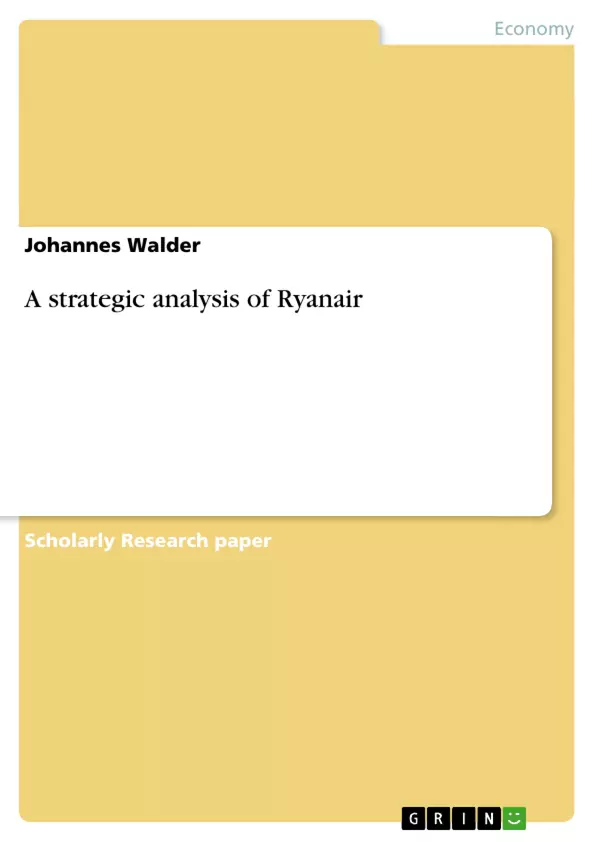This paper will analyse the reason behind the decision for low cost leadership as corporate strategy. Furthermore the implementation of the strategy into their value chain is going to be described and finally it is going to be evaluated if the strategy was successful.
Inhaltsverzeichnis (Table of Contents)
- Introduction
- Analysis of the internal and external factors (SWOT)
- Strengths
- Weaknesses
- Opportunities
- Threats
- Strategic options for Ryanair
- Merger
- Premium strategy
- Cost leadership
- Implementation
- Strategic analysis of Ryanair
- Conclusion
Zielsetzung und Themenschwerpunkte (Objectives and Key Themes)
This paper analyzes the reasons behind Ryanair's decision to adopt a low-cost leadership strategy. It examines the implementation of this strategy within their value chain and evaluates its effectiveness.- The adoption of a low-cost leadership strategy
- The role of Michael O'Leary in shaping Ryanair's strategy
- The impact of the European deregulation on Ryanair's growth
- The evaluation of Ryanair's strategic options
- The effectiveness of Ryanair's chosen strategy
Zusammenfassung der Kapitel (Chapter Summaries)
- Introduction: This chapter introduces Ryanair, its origins, and the rise of Michael O'Leary as CEO, who adapted the company's strategy after the model of Southwest Airlines. The chapter also presents a brief overview of Ryanair's passenger number growth as a testament to the success of their strategy.
- Analysis of the internal and external factors (SWOT): This chapter delves into the internal and external factors that influenced Ryanair's strategic choices, using the SWOT analysis framework. It examines the strengths, weaknesses, opportunities, and threats that shaped the company's strategy.
- Strengths: This chapter highlights Ryanair's charismatic and polarizing CEO, Michael O'Leary, who brought the knowledge of Southwest Airlines' business model and implemented it effectively. It also emphasizes O'Leary's role in promoting the company and generating media attention.
- Weaknesses: This chapter addresses Ryanair's initial inefficiency, characterized by slow turnarounds and high operating costs, which made them a smaller competitor compared to Aer Lingus. It notes that their lack of efficiency resulted in a lack of profitability.
- Opportunities: This chapter discusses the European deregulation as a significant opportunity for Ryanair, facilitating easier market access and expansion into other countries and airports.
- Threats: This chapter identifies the main threats to Ryanair as competition, particularly the increased competition brought about by the deregulation, posing a challenge to the relatively small company.
- Strategic options for Ryanair: This chapter explores the various strategic options available to Ryanair after Michael O'Leary's appointment, using the VRIO method (value, rarity, imitability, and organization). It outlines the options of merger, a premium strategy, and cost leadership.
- Merger: This chapter evaluates the potential benefits and drawbacks of Ryanair merging with a competitor like Aer Lingus, focusing on gaining market share, cost reduction through synergies, and capital base strengthening. It also examines the feasibility of this strategy considering Ryanair's financial resources.
- Premium strategy: This chapter explores the possibility of Ryanair focusing on the premium segment and targeting business customers. It assesses the potential value creation for the business and the competitive landscape, considering the existing competitors like British Airways. It also examines the feasibility of this strategy considering Ryanair's resources.
Schlüsselwörter (Keywords)
This preview primarily explores Ryanair's strategic choices, specifically its adoption of a low-cost leadership strategy, the role of Michael O'Leary in shaping the strategy, and the impact of the European deregulation on Ryanair's growth. The preview also examines the VRIO method, used to analyze Ryanair's strategic options. Key terms include cost leadership, low-cost carrier, Southwest Airlines, European deregulation, VRIO framework, and SWOT analysis.
Excerpt out of 9 pages
- scroll top
- Quote paper
- Johannes Walder (Author), 2012, A strategic analysis of Ryanair, Munich, GRIN Verlag, https://www.grin.com/document/212378
Look inside the ebook



